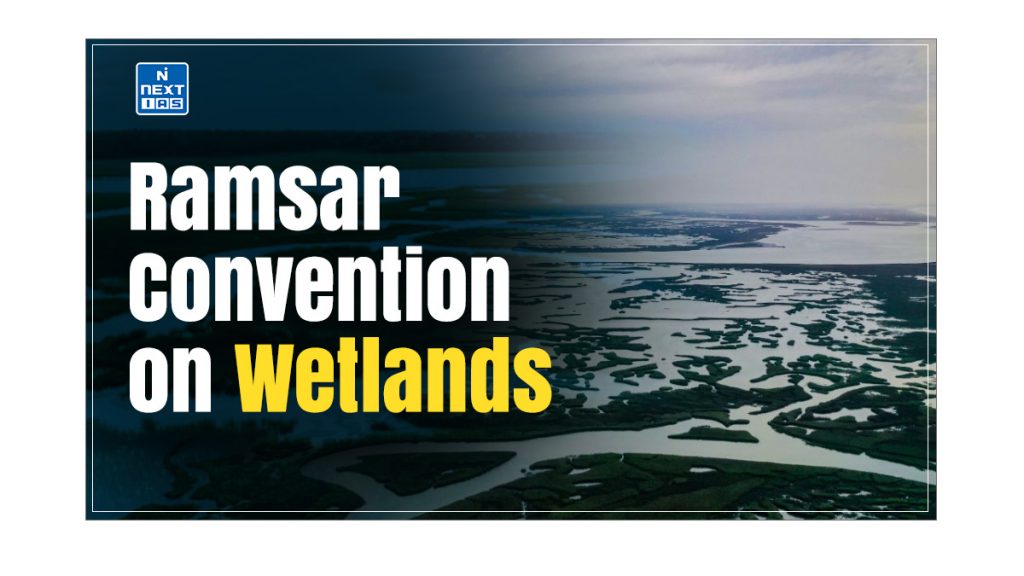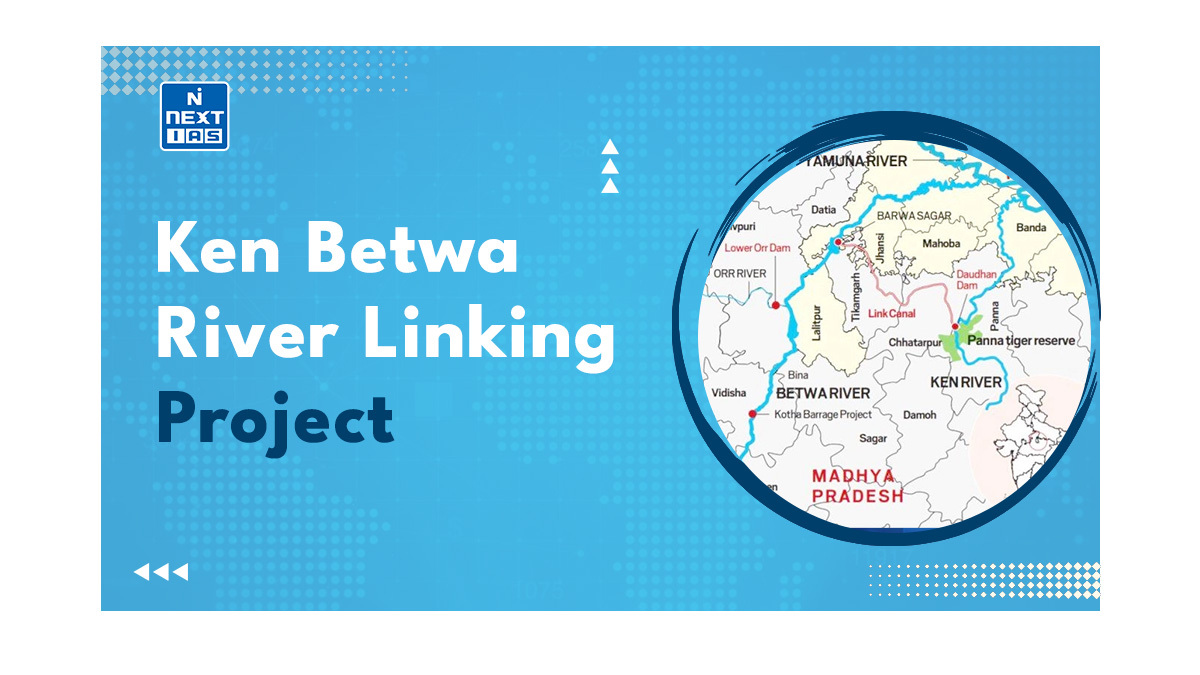
The Ramsar Convention on Wetlands is an international treaty established in 1971 to conserve and promote the sustainable use of wetlands worldwide. Its significance lies in its global framework for protecting wetlands, which are crucial for biodiversity, water resources, and climate change mitigation. This article aims to explore in detail the history, objectives, selection criteria for Ramsar sites, core pillars, and the significance of the Ramsar Convention in protecting wetland ecosystems.
About Wetlands
- Wetlands are vital for human survival. They are among the world’s most productive environments, cradles of biological diversity that provide the water and productivity upon which countless species of plants and animals depend for survival.
- Wetlands are indispensable for the countless benefits or “ecosystem services” that they provide humanity.
- These range from freshwater supply, food and building materials, and biodiversity to flood control, groundwater recharge, and climate change mitigation. They are among the most diverse and productive ecosystems.
- Wetlands provide essential services and supply all our fresh water. However, they continue to be degraded and converted to other uses.
- This has created an urgent need to stop and conserve the loss of wetlands worldwide through wise use and management of wetlands.
Ramsar Convention on Wetlands
- The Ramsar Convention on Wetlands, also known as the Ramsar Convention, is an intergovernmental treaty that provides the framework for national action and international cooperation to conserve and wisely use wetlands and their resources.
- The Ramsar Convention on Wetlands uses a broad definition of wetlands. It includes all lakes and rivers, underground aquifers, swamps and marshes, wet grasslands, peatlands, oases, estuaries, deltas and tidal flats, mangroves and other coastal areas, coral reefs and all human-made sites such as fish ponds, rice fields, reservoirs and salt pans.
History of Ramsar Convention
- The Ramsar Convention, also known as the Convention on Wetlands, originated from the growing global recognition of the need to protect wetlands due to their ecological importance and increasing threats from human activities.
- Environmental and waterfowl conservationists first proposed the idea of an international treaty to safeguard wetlands in the 1960s.
- The Ramsar Convention was formally adopted on February 2, 1971, in the city of Ramsar, Iran, hence its name.
- The primary goal was to create a framework for the conservation and sustainable use of wetlands, which serve as critical habitats for biodiversity, particularly waterfowl.
- The convention officially entered into force on December 21, 1975, after the required number of ratifications.
- Since then, it has evolved to encompass a broader focus on wetland ecosystems, incorporating sustainable development and the conservation of biodiversity.
- As of today, it has nearly 172 contracting parties. This growth reflects its success and importance in global environmental protection efforts.
Objectives of Ramsar Convention
The objectives of the Ramsar Convention are as follows:
- To ensure wetlands’ protection, restoration, and responsible management to maintain their ecological character.
- To encourage collaboration between countries to protect transboundary wetlands and share knowledge, resources, and best practices.
- To contribute to biodiversity conservation and safeguard habitats for various species, particularly waterfowl and aquatic life, by protecting vital wetland ecosystems.
- To support climate regulation and enhance wetlands’ role in carbon sequestration, flood control, and water cycle regulation, contributing to climate resilience.
- To raise public awareness and foster understanding of the importance of wetlands and their benefits to both people and nature.
Criteria for Selection of Ramsar Sites
Ramsar Sites are wetlands designated internationally necessary under the Ramsar Convention, recognising their ecological, cultural, and socio-economic value. These sites are chosen based on specific criteria to protect globally significant wetland habitats and species.
- Unique Wetlands: Sites that contain rare or unique examples of natural or near-natural wetland ecosystems.
- Biodiversity: Wetlands that support vulnerable, endangered, or critically endangered species or provide critical habitats for such species.
- Waterfowl Populations: Sites that regularly support large numbers of waterfowl, especially during migration, breeding, or wintering periods.
- Species Support: Wetlands that support plant or animal species at a critical stage in their life cycles or provide refuge during adverse conditions.
- Fish and Aquatic Life: Sites crucial for fish populations, especially for breeding, spawning, and nursery grounds.
Pillars of Ramsar Convention on Wetlands
- The Ramsar Convention’s mission is “the conservation and wise use of all wetlands through local and national actions and international cooperation, as a contribution towards achieving sustainable development throughout the world”.
- Under the three pillars of the Convention, the Contracting Parties commit to:
- To work toward wise use of all their wetlands through national plans, policies and legislation, management actions and public education.
- To designate suitable wetlands for the Wetlands of International Importance (the “Ramsar List”) and ensure their effective management.
- To cooperate internationally on transboundary wetlands, shared wetland systems, shared species, and development projects that may affect wetlands.
- Contracting Parties commit to working towards the wise use of all wetlands and water resources in their territory through national plans, policies and legislation, management actions, and public education.
- Many countries and donors support the mission of the Ramsar Convention by funding projects around the world.
- The Conference of the Parties provides a core budget every three years to be administered by the Secretariat, and each Contracting Party pays a percentage related to its contribution to the United Nations budget.
- The Convention has five formally recognised “International Organization Partners”, which provide expert technical advice and assistance in line with Convention principles:
- Birdlife International,
- International Union for Conservation of Nature (IUCN),
- International Water Management Institute (IWMI),
- Wetlands International, and
- WWF International.
| The wise use of wetlands refers to “the maintenance of their ecological character, achieved through the implementation of ecosystem approaches, within the context of sustainable development”. Wise use can thus be seen as the conservation and sustainable use of wetlands and all the services they provide, for the benefit of people and nature. |
Ramsar Sites in India
- Ramsar Sites in India are designated wetlands recognised for their ecological importance and biodiversity.
- Currently, India has 49 Ramsar Sites, including notable ones like Chilika Lake, Keoladeo National Park, and Sundarbans.
- These sites are crucial habitats for numerous bird species, aquatic life, and various flora, contributing to the country’s rich biodiversity.
- They also play a vital role in supporting local communities, providing resources and livelihoods while helping to maintain ecosystem services such as flood control and water purification.
Notable Examples of Ramsar Sites Around the World
- The network of Ramsar Sites is truly global and includes coastal and inland wetlands of all types in all six Ramsar regions.
- The world’s first Site was the Cobourg Peninsula in Australia, designated in 1974.
- The largest Sites are Ngiri-Tumba-Maindombe in the Democratic Republic of Congo and Queen Maud Gulf in Canada.
- They each cover over 60,000 square kilometres, and some are as small as one hectare.
- The countries with the most sites are the United Kingdom, with 175 and Mexico, with 142.
- Bolivia has the largest area, 148,000 km2, under Ramsar protection.
- Canada, Chad, Congo and the Russian Federation are also designated over 100,000 km2.
- The world’s largest mangrove forest in Sundarbans, India/Bangladesh, is vital for biodiversity and coastal protection.
- A vast inland delta supporting rich biodiversity, including endangered species in Okavango Delta, Botswana.
- A significant wetland system in Everglades, USA, provides crucial ecosystem services like water filtration and flood control.
Importance of Ramsar Sites for Conservation of Wetlands
The importance of Ramsar Sites are as follows:
- Protecting Biodiversity: Ramsar Sites provide habitats for countless species, particularly migratory birds, fish, and amphibians.
- Supporting Ecosystems: They contribute to water purification, flood control, and nutrient cycling, maintaining ecosystem health and resilience.
- Mitigating Climate Change: Wetlands store carbon and regulate local climates, reducing greenhouse gases and enhancing climate adaptation.
- Supporting Livelihoods: Ramsar Sites provide vital resources such as fish, water, and plants that local communities depend on for food, income, and cultural practices.
- Promoting Ecotourism: Many Ramsar Sites attract tourists for their scenic beauty and biodiversity, helping generate revenue for conservation efforts and boosting local economies.
Montreux Record on Ramsar Sites
- The Montreux Record is a register of wetland sites on the List of Wetlands of International Importance where changes in ecological character have occurred, are occurring, or are likely to occur due to technological developments, pollution, or other human interference.
- At present, India has two wetlands listed in the Montreux Record:
- Keoladeo National Park is in Rajasthan, and
- Loktak Lake is in Manipur.
| Note: Chilika Lake in Odisha, previously included in the record, has since been removed. |
Conclusion
The Ramsar Convention remains a critical international effort to safeguard wetlands and ensure their sustainable use. By designating Ramsar Sites and promoting wise use practices, the convention plays a pivotal role in conserving biodiversity, mitigating climate change, and supporting livelihoods. As more nations collaborate and commit to the convention’s objectives, wetlands will continue to thrive as essential ecosystems, benefiting both people and the planet.
Frequently Asked Questions (FAQs)
What is the Ramsar Convention of Wetlands?
The Ramsar Convention is an international treaty to conserve wetlands and promote their sustainable use.
Which is the First Ramsar Site of India?
The first Ramsar site in India is the Chilika Lake, which was designated in 1981.






